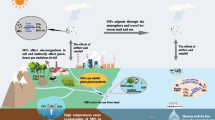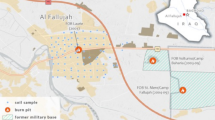Abstract
Polycyclic aromatic hydrocarbons (PAHs), dust, and wax were measured in pine needles, and PAHs were also measured in surface soil. Pearson correlation analysis was performed between the analytical values. The main compounds responsible for the increase in total PAHs were non-carcinogenic phenanthrene and fluoranthene. Therefore, the % content of carcinogenic PAHs decreased with a slope = -0.037 (r = 0.47, p < 0.01), as the total PAH concentration in pine needles increased. Correlations between individual PAHs in pine needles and surface soil were very high when only low-number ring PAHs (2R- and 3R-PAHs) were statistically analyzed and significant when only high-number ring PAHs were statistically analyzed. Low-number ring PAH mainly moves in the gas phase and diffuses into the wax layer, so it was found to be statistically significant with the wax content of pine needles. High-number ring PAHs showed a high correlation with the amount of dust in pine needles because they mainly attached to dust particles and accumulated on the surface of pine needles. The ratios of fluoranthene/pyrene and methylphenanthrene/phenanthrene for predicting the origin of atmospheric PAHs have also been proven valid for pine needles.


Similar content being viewed by others
Data Availability
The datasets generated during and/or analyzed during the current study are available from the corresponding author on reasonable request.
References
Barber JL, Thomas GO, Kerstiens G, Jones KC (2004) Current issues and uncertainties in the measurement and modelling of air-vegetation exchange and within-plant processing of POPs. Environ Pollut 128:99–138
Boonyatumanond R, Wattayakorn G, Togo A, Takada H (2006) Distribution and origins of polycyclic aromatic hydrocarbons (PAHs) in riverine, estuarine, and marine sediments in Thailand. Mar Pollut Bull 52:942–956
Chung D, Lee JH, Lee SY, Oh YS, Shin HS (2022) Quantitative analysis and contamination profiles of PCBs, OCPs, and PAHs in black-tailed gull eggs in the Republic of Korea. Environ Monit Assess 194:268
Dine EJA, Mokbel H, Elmoll A, Massemin S, Vuilleumier S, Toufaily J, Hanieh T, Millet M (2015) Concomitant evaluation of atmospheric levels of polychlorinated biphenyls, organochlorine pesticides, and polycyclic aromatic hydrocarbons in Strasbourg (France) using pine needle passive samplers. Environ Sci Pollut Res 22:17850–17859
Gorshkov AG (2008) Determination of polycyclic aromatic hydrocarbons in the needles of a Scotch pine (Pinus sylvestris L.), a biomonitor of atmospheric pollution. J Anal Chem 63:805–811
Hanedar A, Alp K, Kaynak B, Baek J, Avsar E, Odman MT (2011) Concentrations and sources of PAHs at three stations in Istanbul Turkey. Atmos Res 99:391–399
Haritash AK, Kaushik CP (2009) Biodegradation aspects of polycyclic aromatic hydrocarbons (PAHs): a review. J Hazard Mater 169:1–15
Hellström A (2003) Uptake of airborne organic pollutants in pine needles geographical and seasonal variations, Doctoral thesis Swedish University of Agricultural Sciences Uppsala
Hwang HM, Wade TL (2003) Concentrations and source characterization of polycyclic aromatic hydrocarbons in pine needles from Korea, Mexico, and United States. Atmos Environ 37:2259–2267
IARC, International Agency for Research on Cancer (2013) Agents classifed by the IARC monographs (Lyon)
McLachlan MS, Horstmann M (1998) Forests as filters of airborne organic pollutants: a model. Environ Sci Technol 32:413–420
NIH (2008) National Institutes of Health Image, https://imagej.nih.gov/nih-image/. Accessed 31 March 2023
Nuno R, Arminda A, Elefteria P (2011) Biomonitoring of polycyclic aromatic hydrocarbons contamination in the island of Crete using pine needles. Water Air Soil Pollut 215:189–203
Ratola N, Alves A, Kalogerakis N, Psillakis E (2008) Hollow-fibre liquid-phase microextraction: a simple and fast cleanup step used for PAHs determination in pine needles. Anal Chim Acta 618:70–78
Silva JA, Ratola N, Ramos S, Homem V, Santos L, Alves A (2015) An analytical multi-residue approach for the determination of semi-volatile organic pollutants in pine needles. Anal Chim Acta 858:24–31
Sun F, Wen D, Kuang Y, Li J, Li J, Zuo W (2010) Concentrations of heavy metals and polycyclic aromatic hydrocarbons in needles of Masson pine (Pinus massoniana L.) growing nearby different industrial sources. J Environ Sci 22:1006–1013
Tobiszewski M, Namiesnik J (2012) PAH diagnostic ratios for the identification of pollution emission sources. Environ Pollut 162:110–119
Turgut C, Mazmanci MA, Mazmanci B, Yalçin M, Karakuş PK, Atatanir L, Keski M, Henkelmann B, Pfister G, Schramm KW (2017) Polycyclic aromatic hydrocarbons (PAHs) determined by pine needles and semipermeable membrane devices along an altitude profile in Taurus Mountains, Turkey. Environ Sci Pollut Res Int 24:7077–7087
van Drooge BL, Garriga G, Grimalt JO (2014) Polycyclic aromatic hydrocarbons in pine needles (Pinus halepensis) along a spatial gradient between a traffic intensive urban area (Barcelona) and a nearby natural park. Atmos Poll Res 5:398–403
Wang XT, Ying Zhou Y, Hu BP, Fu R, Cheng HX (2019) Biomonitoring of polycyclic aromatic hydrocarbons and synthetic musk compounds with Masson pine (Pinus massoniana L.) needles in Shanghai. China Environ Poll 252:1819–1827
Yunker MB, Macdonald RW, Vingarzan R, Mitchell RH, Goyette D, Sylvestre S (2002) PAHs in the Fraser River basin: a critical appraisal of PAH ratios as indicators of PAH source and composition. Org Geochem 33:489–515
Zeisler-Diehl V, Muller Y, Schreiber L (2018) Epicuticular wax on leaf cuticles does not establish the transpiration barrier, which is essentially formed by intracuticular wax. J Plant Physiol 227:66–74
Zhang W, Zhang S, Wan C, Yue D, Ye Y, Wang X (2008) Source diagnostics of polycyclic aromatic hydrocarbons in urban road runoff, dust, rain and canopy throughfall. Environ Pollut 153:594–601
Acknowledgements
This work was supported by the National Institute of Environment Research (NIER) funded by the Ministry of Environment (MOE) of the Republic of Korea (Grant No.: NIER-2020-01-01-058).
Author information
Authors and Affiliations
Corresponding author
Ethics declarations
Conflict of interest
The authors declare that they have no known competing financial interests or personal relationships that could have appeared to influence the work reported in this paper.
Additional information
Publisher's Note
Springer Nature remains neutral with regard to jurisdictional claims in published maps and institutional affiliations.
Rights and permissions
Springer Nature or its licensor (e.g. a society or other partner) holds exclusive rights to this article under a publishing agreement with the author(s) or other rightsholder(s); author self-archiving of the accepted manuscript version of this article is solely governed by the terms of such publishing agreement and applicable law.
About this article
Cite this article
Chung, D., Kim, T.K., Park, K.W. et al. Distribution of 35 Polycyclic Aromatic Hydrocarbons in Pine Needle Samples from Selected Locations in the Republic of Korea. Bull Environ Contam Toxicol 112, 74 (2024). https://doi.org/10.1007/s00128-024-03887-w
Received:
Accepted:
Published:
DOI: https://doi.org/10.1007/s00128-024-03887-w




